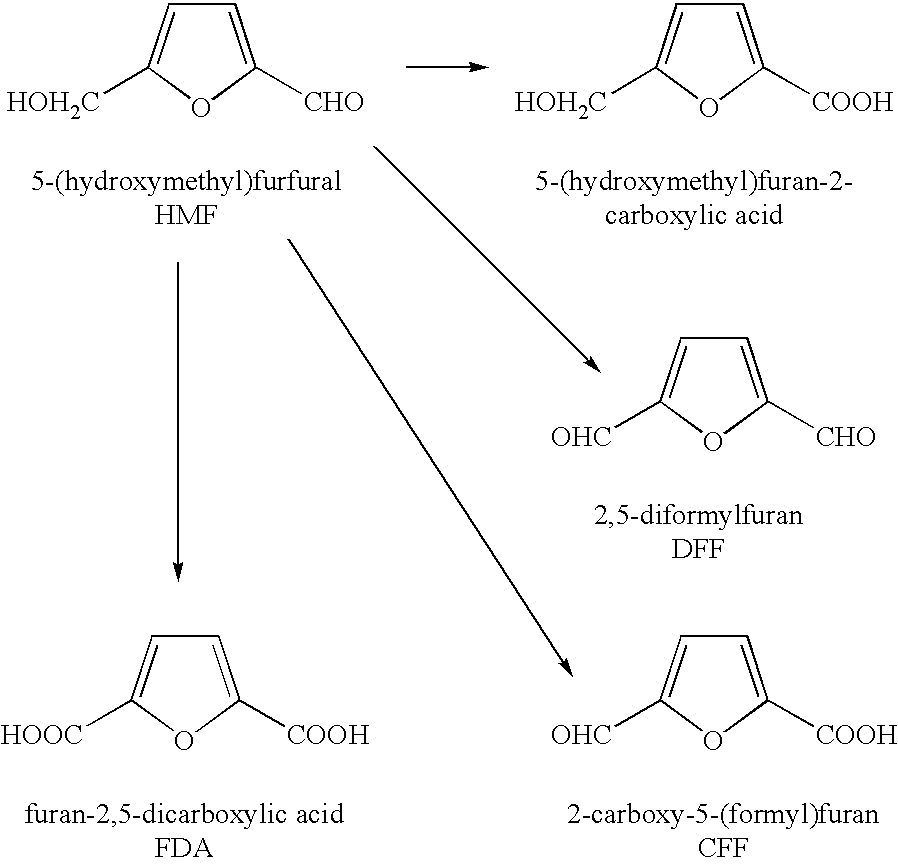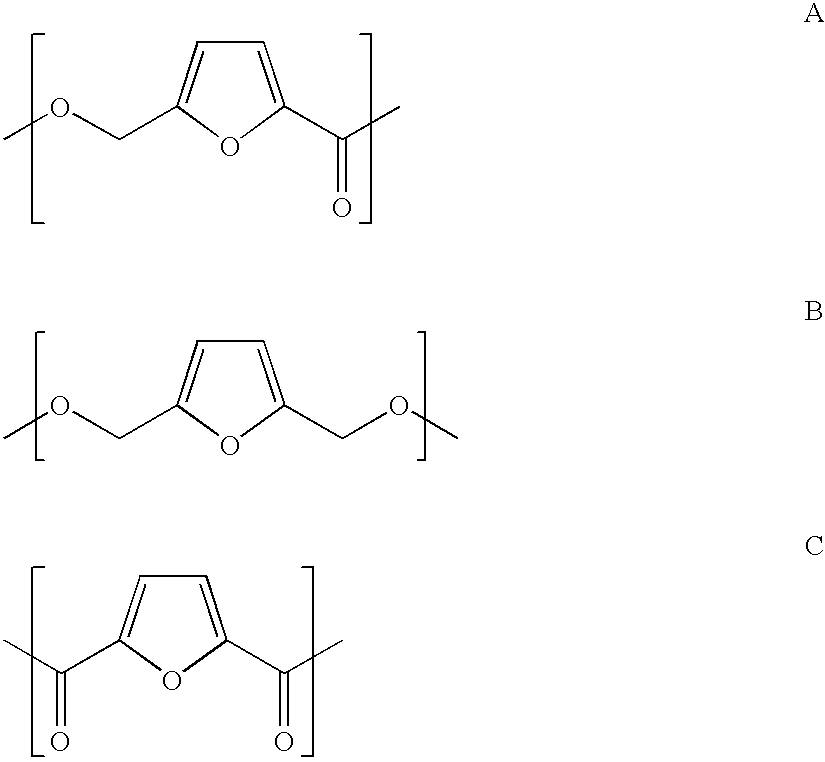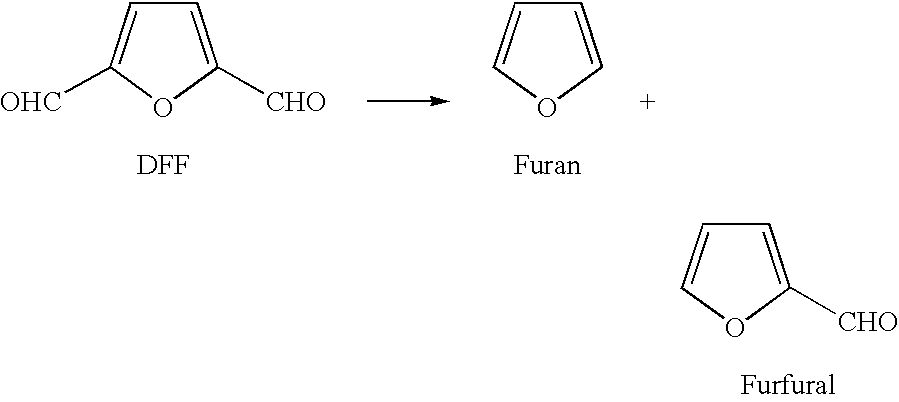Oxidation of 5-(hydroxymethyl) furfural to 2,5-diformylfuran and subsequent decarbonylation to unsubstituted furan
a technology of diformylfuran and hydroxymethyl furfur, which is applied in the direction of carbonyl compound preparation, carbonyl compound preparation by oxidation, carboxylic compound preparation, etc., can solve the problem of large amounts of inorganic salts as waste, difficult methods, and difficult selective oxidation of alcohol functionality in the presence of aldehyde functionality on the same compound
- Summary
- Abstract
- Description
- Claims
- Application Information
AI Technical Summary
Benefits of technology
Problems solved by technology
Method used
Image
Examples
examples 1-6
Reaction of HMF to DFF at Ambient Air Pressure
[0060]In a cylindrical glass fitted with a stirrer and baffles, 0.165 g of cobalt(II) acetate tetrahydrate, 0.169 g of manganese(H) acetate tetrahydrate, 0.142 g of sodium bromide, 0.220 g biphenyl (GC internal standard), and 10.02 g of 5-hydroxymethyl(furfural) were admixed with 100 g of acetic. The solution was purged with nitrogen gas and the temperature raised to 75° C. using an external oil bath. The nitrogen was replaced with air at a flow rate of 100 ml / min at ambient atmospheric pressure. The vent oxygen was constantly monitored and occasionally liquid and vent gas samples for GC analysis were taken at the times shown in Table 2. After 30 hrs the reaction was terminated. The results from the liquid samples taken from the reactor during reaction of Example 1 are given in Table 1. The DFF yield increased with time to a maximum yield of 51% and then decreases thereafter. The mini-reactor data is summarized in Table 3. The rate of re...
examples 7-15
Reaction of HMF to DFF
[0065]Table 3 further illustrates that placing HMF with acetic acid and catalyst metals and then subjecting them to 1000 psi air pressure (7 MPa), can produce high yields of DFF. Molar yields up to 63% were obtained. The yield varied with temperature and type of catalyst used.
[0066]
TABLE 3Initial Conditions for the Oxidation of HMF in Shaker TubesHMF,HMF,DFF yld,Ex.CatalystHMF, gCo, ppmMn, ppmHBr, ppmZr, ppmTemp, ° C.Time, hrconv., %select. %%7Co / Mn / Br / Zr0.25042031895512050260.466.640.28Co / Mn / Br / Zr0.248140637811022050269.265.345.29CofMn / Br0.2519203189551050260.638.423.310Co / Mn / Br0.2524063781102050261.754.633.711Co0.2516700000050248.322.811.012Co / Mn / Br / Zr0.252031895512075282.573.260.413Co / Mn / Br / Zr0.251740637811022075299.761.661.414Co / Mn / Br0.252920318955107527154.338.615Co / Mn / Br0.25144063781102075292.268.363.0
examples 16-40
The Reaction of HMF to CFF and FDA
[0067]Placing HMF in reactors with acetic acid and catalyst metals and having them react with air at 1000 psi (7 MPa) gave good yields of FDA. A particular advantage of this method is that the majority of FDA precipitates from solution upon cooling to room temperature. The yields to CFF and FDA, reported on Table 4, are those which were obtained from the solids only. Table 4 illustrates that different catalysts such as those using cobalt, or a mixture such as Co / Mn / Br and Co / Mn / Zr / Br all produced good yields of FDA. It also illustrates that increasing catalyst concentrations at a given temperature and time, nearly always increased the FDA yield.
[0068]Examples 35 through 37 are to be compared to Examples 38 through 40. In the latter series the temperature was staged-initially it was held at 75° C. for 2 hrs and then raised to 150° C. for two hrs. This staging of the temperature gave higher yields.
[0069]
TABLE 4Reaction of HMF to CFF and FDA All reacti...
PUM
| Property | Measurement | Unit |
|---|---|---|
| temperatures | aaaaa | aaaaa |
| temperatures | aaaaa | aaaaa |
| temperatures | aaaaa | aaaaa |
Abstract
Description
Claims
Application Information
 Login to View More
Login to View More - R&D
- Intellectual Property
- Life Sciences
- Materials
- Tech Scout
- Unparalleled Data Quality
- Higher Quality Content
- 60% Fewer Hallucinations
Browse by: Latest US Patents, China's latest patents, Technical Efficacy Thesaurus, Application Domain, Technology Topic, Popular Technical Reports.
© 2025 PatSnap. All rights reserved.Legal|Privacy policy|Modern Slavery Act Transparency Statement|Sitemap|About US| Contact US: help@patsnap.com



